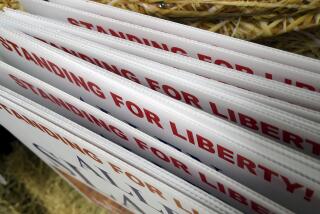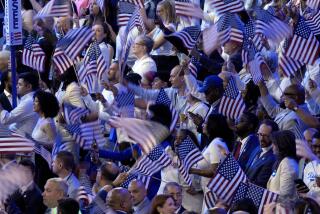Real Americans
As Sarah Palin “aw-shucks-ed” her way through Thursday’s debate, she repeatedly played the one card that has become her stock in trade: She is a real American. Her rural roots, her lack of sophistication and worldliness, her bare bones education, her plain-spokenness, her moose hunting -- all of these seemed to brand her as a typical American, one of us. She has even taken to calling herself Jane Sixpack.
This characterization, ludicrous as it may be in a country as diverse as ours, is more than a matter of political aesthetics. One of the most important components of our recent presidential elections is the redefinition -- actually the narrowing of the definition -- of what constitutes an American. Since 2000 at least, we’ve been asking ourselves which candidate is the one we’d rather belly up to the bar with for a beer. Never mind George W. Bush’s Brahmin pedigree and Yale education; he reinvented himself as a cowboy. By comparison, Al Gore was ridiculed as a Harvard stiff and John Kerry as Frenchified. Now Barack Obama is being subjected to the same mockery.
It is tempting to attribute this sort of demagoguery entirely to Republican calculation. By constantly promoting the notion that Republicans are just a bunch of NASCAR fans and that Democrats are effete, the GOP has successfully divided the country not between red and blue politics but between one version of America and another, between the allegedly authentic and the allegedly inauthentic. But in reality, Republicans have only been exploiting a vein deep within the American consciousness. And who can blame them? What Republicans realize is that most Americans always have been desperately afraid of being seen as phony, and they are actively hostile toward anyone with airs. In fact, liberty is only one foundation of America. The nation rests just as securely on fear and resentment.
In the beginning, that resentment was understandably directed against the British. American rebels needed a strong sense of identity, something that would anoint them as unique and fill them with pride. And although the founding fathers may have embraced elitism and looked askance on true democracy, ordinary Americans nurtured a particular vision of themselves as homespun, pragmatic and lacking the affectations of Europe. In short, real.
One of the first national icons was Daniel Boone -- uneducated, adventurous, a man of action rather than intellect who, in his buckskins, couldn’t have been more different from the typical Englishman and who, historian Richard Slotkin has written, was the perfect model “when the newly independent nation was looking for some self-image appropriate to its stature and ideology.” Boone was a NASCAR frontiersman.
It wasn’t long before the equation of rustic-with-real permeated the culture, from the “Leatherstocking” novels of James Fenimore Cooper early in the 19th century right through to the novels of Henry James, who wrote about honest American innocents swindled by European connivers, late in the century. And then as now, politicians felt obligated to demonstrate their rusticated roots or else be accused of aristocratic arrogance, America’s cardinal sin. That’s why a well-off railroad attorney named Abraham Lincoln was promoted as a penniless bumpkin rail splitter, and why even Daniel Webster made it clear to opponents that he was born in a log cabin.
But it was Andrew Jackson, a Democrat, who converted “common man” appeal into a political movement and gave the rustic-as-real definition power. Jackson understood American resentments. He understood that ordinary Americans fought condescension (and class divisions) by reveling in the very behaviors that elicited that condescension from their social and economic betters. And he understood that most Americans liked to define themselves as much by what they were not as by what they were, what they hated as much as what they loved. One of his campaign slogans in 1828 boasted that the election pitted “John Quincy Adams who can write” against “Andrew Jackson who can fight.”
Frankly, the idea of who is a real American hasn’t changed much since then, though it did take a detour. Industrialization and urbanization attacked the very roots of the old Boone/Jackson idea of backwoods authenticity. As more and more Americans left the farm for the city, as more worked on assembly lines, as more immigrants came from overseas, they no longer resembled Natty Bumppo. Real Americans were now as likely to wear blue collars as plaid shirts and overalls (not to mention buckskins) because real Americans were quite simply those who were not unreal Americans -- elitists, snobs, intellectuals, socialists and other categories of cosmopolitan strivers.
Still, if the basis of authenticity didn’t change much, the political exploitation of it did. Seizing on the new blue-collar cohort, Franklin Roosevelt reinvigorated the Jacksonian identification of real Americans with the Democratic Party, in part by responding to their economic grievances but also by labeling Republicans as the party of the wealthy and culturally superior -- that old American raw nerve. (Never mind FDR’s actual “to the manner born” identity.)
And that’s when it began to get tricky. Having lost the battle for real Americans during the Depression, the Republican Party sought to regain the populist initiative by redefining its opposition as elite. A large part of Sen. Joseph McCarthy’s appeal was that he recast the Cold War in cultural terms. On one side were the real Americans -- salt-of-the-earth patriots. And on the other side were the modern equivalents of the once-detested Englishmen -- Ivy League-educated, supercilious mandarins like Alger Hiss who, in this new formulation, preferred European communism to American common sense. In effect, McCarthy re-politicized American identity by not just denying the Americanness of anyone who wasn’t working class or rural, but by turning them into traitors, which neither Jackson nor Roosevelt had attempted.
--
McCarthy’s equation didn’t really take hold until the Vietnam War, when opposition itself would be cast as un-American. This was Richard Nixon’s major contribution to our political taxonomy. For Nixon, America was cleaved between the vast Silent Majority (real) who agreed with him, supported the war and detested protesters and pointy-headed academics, and those protesters and academics who disagreed with him (unreal).
Republicans have been feasting on this division ever since, and so have the media, most likely because they fear being stigmatized by the same elitism. Everyone wants to be real, even if being real Americans looks suspiciously like being a hidebound conservative.
It is a neat gambit -- to conflate “real” with Republican and “un-American” with Democrats -- neater still when there are fewer and fewer Americans who fit the most colorful aspects of authenticity represented by a Sarah Palin.
If the country keeps clinging to this reductive stereotype despite its absurdity, it may be because we have never quite lost those powerful early American impulses. Our resentments against elitists still burn, our anger against our “betters” is still hot, and our fear of being called a phony still roars. Just ask any Republican.
More to Read
Get the L.A. Times Politics newsletter
Deeply reported insights into legislation, politics and policy from Sacramento, Washington and beyond. In your inbox three times per week.
You may occasionally receive promotional content from the Los Angeles Times.










